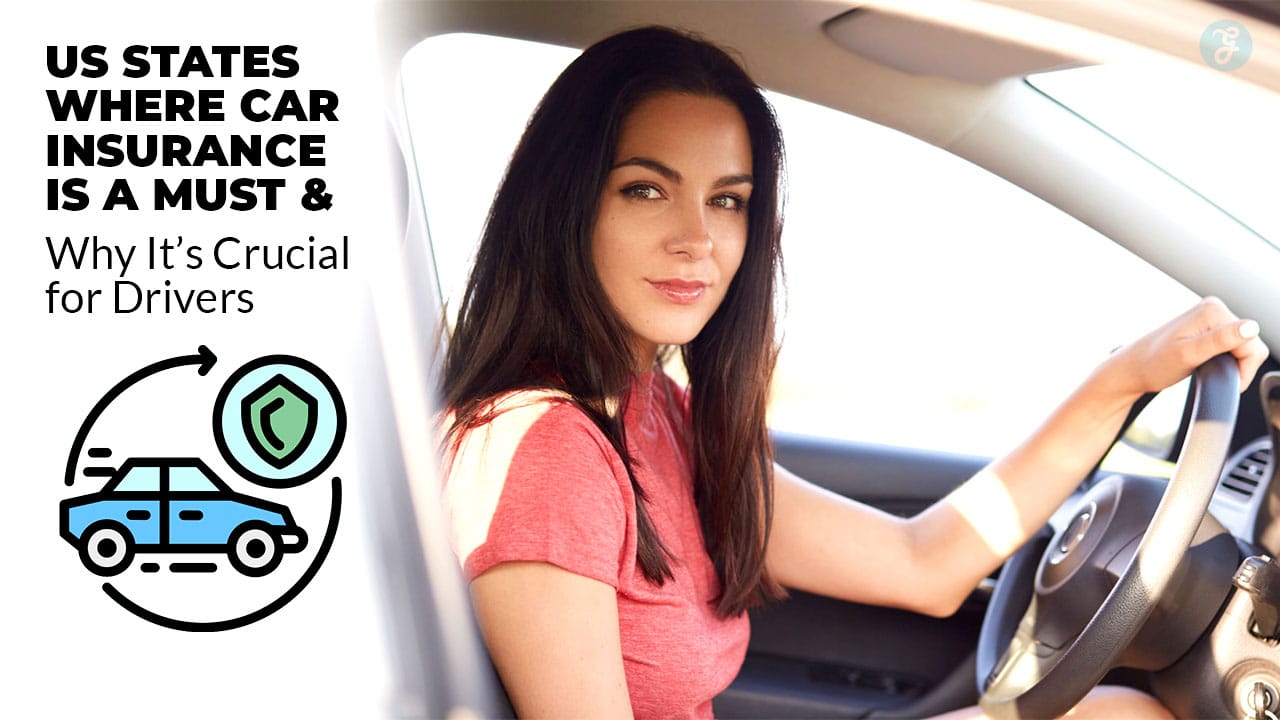Driving without car insurance in the United States can lead to serious financial and legal consequences.
While all states have some form of car insurance requirement, the degree of enforcement and minimum coverage varies.
In this article, we explore the US states where car insurance is a must, the reasons behind strict insurance mandates, and the implications of non-compliance.
Whether you’re a new driver, relocating to a different state, or just looking to stay informed, this guide provides everything you need to know about the US states where car insurance is must.
Why Car Insurance Is Mandatory in Certain States?
Car insurance is more than just a legal obligation; it’s a crucial safety net that protects drivers, passengers, and pedestrians.
Let’s delve into why some US states where car insurance is a must enforce stricter regulations than others.
The Role of Car Insurance in Road Safety and Liability
- Financial Protection: Car insurance ensures that drivers can cover damages in case of an accident, reducing out-of-pocket expenses.
- Compensation for Victims: Insurance guarantees that victims receive proper medical and financial support after accidents.
- Promoting Responsibility: Mandatory insurance fosters responsible driving by holding drivers accountable for their actions.
- Reducing State Burdens: With insurance mandates, states can avoid bearing the financial strain of accidents caused by uninsured drivers in the US states where car insurance is a must.
Legal Requirements Across the United States
While most states mandate liability insurance, the extent of coverage varies. The penalties for uninsured driving can include hefty fines, suspension of licenses, and even criminal charges.
These strict measures make certain US states where car insurance is a must stand out.
| Key Insurance Metrics Across the US | Statistic |
| Average Annual Car Insurance Premium | $1,553 |
| Percentage of Uninsured Drivers | 12.6% |
| States with No-Fault Insurance Laws | 12 States |
| States Allowing Uninsured Motorist Fee | 2 States (Virginia, New Hampshire) |
Top 10 US States Where Car Insurance Is a Must
Certain states have stricter car insurance requirements due to factors like high accident rates, no-fault insurance laws, or unique legal structures.
Here are the top US states where car insurance is a must, and why:
| State | Bodily Injury Coverage (Per Person) | Bodily Injury Coverage (Per Accident) | Property Damage Coverage |
| California | $15,000 | $30,000 | $5,000 |
| Florida | $10,000 (PIP) | N/A | $10,000 |
| Texas | $30,000 | $60,000 | $25,000 |
| New York | $25,000 | $50,000 | $10,000 |
| Michigan | Unlimited (PIP) | Unlimited | N/A |
| Illinois | $25,000 | $50,000 | $20,000 |
| Georgia | $25,000 | $50,000 | $25,000 |
| Pennsylvania | $15,000 | $30,000 | $5,000 |
| Nevada | $25,000 | $50,000 | $20,000 |
| Virginia | $25,000 | $50,000 | $20,000 |
1. California
California’s sprawling highways and dense urban centers make it one of the busiest states for drivers. As a result, insurance laws are designed to protect all road users.
- Key Reasons for Strict Insurance Laws: California’s high population density and busy highways increase the risk of accidents, making insurance mandatory.
- Minimum Coverage Requirements: Drivers must have liability insurance covering $15,000 for injury/death of one person, $30,000 for injury/death of more than one person, and $5,000 for property damage.
- Penalties for Non-Compliance: Uninsured drivers face fines, license suspension, and vehicle impoundment.
Example: In Los Angeles, uninsured drivers involved in at-fault accidents have faced penalties exceeding $2,500.
| Category | Details |
| Minimum Liability | $15,000/$30,000/$5,000 |
| Penalty for Violation | Fines, license suspension |
| Unique Factor | High-density urban driving |
2. Florida
Known for its tourism and traffic-heavy areas, Florida has unique insurance laws that reflect its population’s needs.
- Unique Requirements for Personal Injury Protection (PIP): Florida’s no-fault insurance system mandates PIP coverage to handle medical expenses regardless of fault.
- High Accident Rates: With one of the highest accident rates in the country, Florida enforces strict penalties for uninsured drivers.
- Additional Insights: Florida’s laws ensure quicker payouts for medical care, benefiting drivers and reducing litigation rates.
Tip: Bundle PIP with uninsured motorist coverage for added protection against at-fault uninsured drivers.
| Category | Details |
| Minimum Liability | $10,000 PIP |
| Penalty for Violation | Fines, vehicle impoundment |
| Unique Factor | No-fault insurance system |
3. Texas
As the second-largest state by area, Texas’ highways see heavy use, leading to robust insurance laws.
- Liability-Only Coverage Rules: Texas requires drivers to carry at least $30,000 per injured person, up to $60,000 per accident, and $25,000 for property damage.
- Legal Consequences: Failure to provide proof of insurance results in fines and possible vehicle impoundment.
- Case Study: In 2022, uninsured accidents in Texas accounted for 13% of highway fatalities, prompting stricter enforcement.
Tip: Enroll in safe driving courses to qualify for premium discounts.
| Category | Details |
| Minimum Liability | $30,000/$60,000/$25,000 |
| Penalty for Violation | Fines, vehicle impoundment |
| Unique Factor | Highways with heavy traffic |
4. New York
New York’s bustling cities and varied weather conditions make car insurance critical for safety and accountability.
- No-Fault Insurance System Explained: New York’s no-fault system requires drivers to carry PIP coverage to ensure quick medical payouts after accidents.
- Coverage Limits: Minimum requirements include $25,000 for bodily injury, $50,000 for death, and $10,000 for property damage.
- Notable Trend: The state’s electronic monitoring system has improved compliance rates significantly.
Example: A 2023 initiative saw the implementation of automatic compliance alerts, reducing uninsured driving by 10%.
| Category | Details |
| Minimum Liability | $25,000/$50,000/$10,000 |
| Penalty for Violation | License suspension, fines |
| Unique Factor | Advanced compliance systems |
5. Michigan
Michigan’s insurance landscape is unique due to its no-fault system and comprehensive coverage requirements.
- Mandatory Personal Protection Insurance (PPI): Michigan’s no-fault insurance includes unlimited medical benefits, making it one of the strictest US states where car insurance is a must.
- Impact on Drivers: Despite high premiums, this system ensures comprehensive protection for all parties involved.
Example: A 2019 study showed that Michigan’s no-fault insurance saved over $2 billion in medical costs compared to liability-only systems.
Tip: Compare multi-policy discounts to offset high premiums.
| Category | Details |
| Minimum Liability | Unlimited (PIP) |
| Penalty for Violation | Heavy fines, license loss |
| Unique Factor | Unlimited medical benefits |
6. Illinois
Illinois balances accessibility and enforcement through a robust verification system.
- Verification Programs and Enforcement: Illinois uses an electronic verification system to ensure drivers comply with mandatory insurance laws.
- Reasons for Strict Mandates: High urban traffic and accident rates necessitate stringent regulations.
- Practical Insight: Over 90% compliance rate achieved through annual vehicle registration checks.
Tip: Review insurance policies annually to ensure compliance and explore savings opportunities.
| Category | Details |
| Minimum Liability | $25,000/$50,000/$20,000 |
| Penalty for Violation | Fines, registration blocks |
| Unique Factor | Electronic verification |
7. Georgia
Georgia’s insurance requirements stem from its high accident rates and urban congestion, especially in cities like Atlanta.
- High Penalties for Driving Uninsured: Georgia imposes fines, license suspension, and even jail time for uninsured drivers.
- How Car Insurance Reduces Financial Risks: Mandatory liability coverage protects drivers from crippling financial liabilities after accidents.
- Case Study: Following stricter law enforcement in 2021, uninsured driver rates in Georgia dropped by 15%.
Tip: Bundle auto and home insurance to save up to 20% on premiums.
| Category | Details |
| Minimum Liability | $25,000/$50,000/$25,000 |
| Penalty for Violation | Fines, license suspension |
| Unique Factor | High urban traffic rates |
8. Pennsylvania
Pennsylvania strikes a balance between flexibility and enforcement through its optional tort coverage.
- Unique Laws About Limited vs. Full Tort Insurance: Drivers can choose between limited and full tort options, impacting their ability to sue for pain and suffering.
- Compliance Requirements: Pennsylvania requires liability and medical benefits coverage.
- Notable Data: In 2022, over 90% of drivers opted for limited tort to reduce premiums.
Tip: Choose full tort if frequent highway use is unavoidable for added protection.
| Category | Details |
| Minimum Liability | $15,000/$30,000/$5,000 |
| Penalty for Violation | License suspension, fines |
| Unique Factor | Optional tort insurance |
9. Nevada
Nevada’s bustling tourism industry and traffic-heavy roads necessitate robust insurance laws.
- Minimum Coverage Limits for Liability: Nevada mandates $25,000 for bodily injury per person, $50,000 per accident, and $20,000 for property damage.
- Impact of High Tourism: The influx of tourists increases traffic, making Nevada one of the US states where car insurance is a must.
- Enforcement Trends: Nevada’s frequent checkpoints ensure compliance with insurance laws.
Tip: Seek accident forgiveness policies to manage premium hikes.
| Category | Details |
| Minimum Liability | $25,000/$50,000/$20,000 |
| Penalty for Violation | Fines, vehicle impoundment |
| Unique Factor | High tourism traffic |
10. Virginia
Virginia takes a unique approach by allowing drivers to pay an uninsured motorist fee as an alternative to purchasing insurance.
- Option for Uninsured Motorist Fees: Virginia offers an uninsured motorist fee of $500, allowing drivers to avoid standard insurance but assumes full liability for damages.
- Balancing Legal and Financial Implications: This unique approach ensures flexibility while maintaining accountability.
- Example: Despite this option, over 75% of drivers still opt for traditional insurance due to its broader protections.
Tip: Always opt for uninsured motorist coverage even if using fee-based options.
| Category | Details |
| Minimum Liability | $25,000/$50,000/$20,000 |
| Penalty for Violation | Fines, license suspension |
| Unique Factor | Uninsured motorist fee |
Consequences of Driving Without Insurance
Failing to comply with car insurance requirements can lead to severe repercussions, especially in US states where car insurance is a must:
Financial Penalties and Fines
Uninsured drivers face fines ranging from $100 to $5,000 depending on the state and severity of the violation.
For example, California imposes fines up to $1,000 for repeat offenses, while Florida’s penalties often exceed $500.
Suspension of License and Registration
Many states, including California and Texas, suspend the driver’s license and vehicle registration for non-compliance.
This suspension can last from 30 days to several months.
Legal Consequences: Civil vs. Criminal Charges
In some cases, driving uninsured can lead to civil lawsuits or even criminal charges, especially if the driver causes an accident.
Michigan, for instance, enforces criminal penalties for repeat offenders.
Tips for Finding Affordable Car Insurance
While insurance is mandatory, finding affordable options is possible. Here are some tips:
- Compare Rates Across Providers: Use online tools to compare quotes from multiple insurers.
- Look for Discounts: Many providers offer discounts for safe driving, bundling policies, or having good credit.
- Review Policy Coverage: Ensure your policy meets state requirements without unnecessary add-ons.
- Example: A recent survey found that bundling home and auto insurance can save up to 25% annually.
- Real-Time Data Insight: According to 2023 data from the Insurance Information Institute, safe driver discounts can reduce premiums by 15-30%.
Final Thoughts
Car insurance is more than a legal requirement; it’s a lifeline that safeguards drivers, passengers, and pedestrians alike.
By understanding the laws in US states where car insurance is a must, you can avoid penalties, protect your finances, and drive with peace of mind.
Stay informed, compare policies, and prioritize coverage to navigate the roads responsibly.





































